Dental bridges
At Tetri’s Smile, we place dental bridges on severely damaged or missing teeth. We use a comprehensive treatment method for the jaw and dental arch. We will restore the aesthetics and preserve the function of the teeth, even in the most difficult cases.
A fixed bridge is a permanent denture to replace one or more missing teeth. It is placed on the supporting units or implants with crowns that are connected to the pontic – an artificial crown closes the interdental space.
Why do you need a dental bridge? If you lose 1-2 units, the adjacent teeth will begin to shift due to the chewing load. This may cause bite problems, pain, or loss of other units. Entrust the restoration of teeth to experienced professionals!
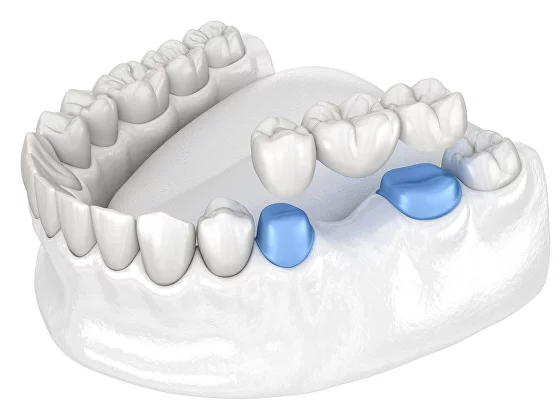
Dental bridge: Before and after
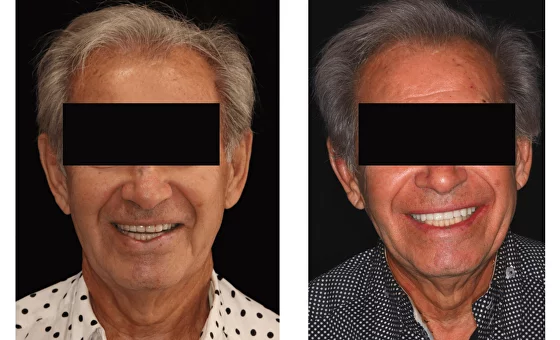
A patient came to Dr. Tetri with a severe toothache and inflammation under the crowns. After diagnosing and studying his medical background, the doctor prepared a treatment plan and set up a time for treatment.
As a result, Dr. Tetri performed the treatment and restored the teeth. He installed multiple implants and dentures on the same day and placed fixed bridges.
When do you need a dental bridge?
The absence of one or more teeth is a direct indication for a dental bridge. Such clinical cases include:
- Missing 1-2 canines or incisors in the smile area
- Loss of units in the masticatory region – 2 molars or premolars
- Free-end saddle defect (requires implants).
The doctor will assess the clinical situation and choose a denture option for the missing units. The main condition for placing a dental bridge is the presence of two supports. If the teeth are loose or badly damaged, the denture is fixed on implants.
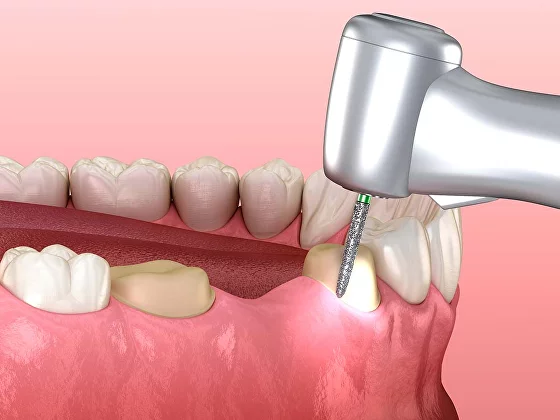
The price of a dental bridge depends on:
The number of interdental spaces to be closed
Crown material
Additional procedures (orthodontic or gneuromuscular treatment)
Restoration site (whether it can be restored on supporting teeth or implants)
*individually discussed
Replacing damaged or missing teeth at Tetri’s Smile

Benefits of treatment by Dr. Tetri:
- Advanced treatment, using gneuromuscular dentistry (GNM) to restore proper occlusion
- Replacement of a damaged or lost tooth takes just 1 day
- A smile makeover – a full-fledged dental restoration.
Schedule an appointment, and we will discuss your symptoms and prepare a detailed treatment plan.
Dental bridges at an in-house laboratory
Types of dental bridges
The bridge is placed on the supporting units after a preliminary preparation of the dental tissue. As a rule, 1-1.5 mm of dental tissue is treated for zirconia or ceramic. Ceramics are placed in the smile area; zirconium dioxide – in the chewing area (withstanding a heavy load).
A 3-crown denture is placed on natural teeth. Long dental bridges are placed only if there is additional support (implants). In some cases, it is possible to place a denture on 4 units (zirconium dioxide only).
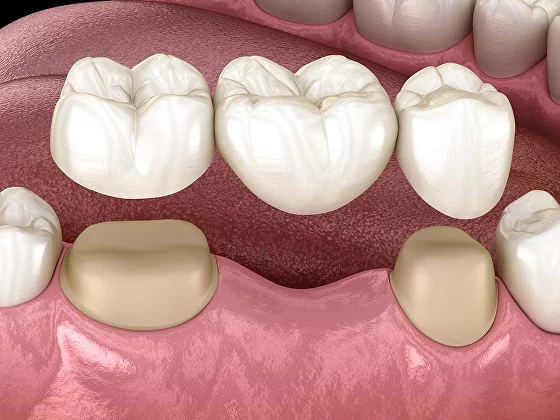
A bridge on implants is the best option if multiple units are missing. This does not require dentin resurfacing or nerve removal. The artificial root stops bone atrophy under the crown. The alveolar ridge does not shrink, making it easier to form a beautiful gingival contour.
Dentures on implants are indicated for wide dental defects. For example, if 4 units in a row are missing in the frontal area or more than 2 molars are missing in the chewing area. A completely edentulous jaw is restored with a full denture using All-on-X technology.
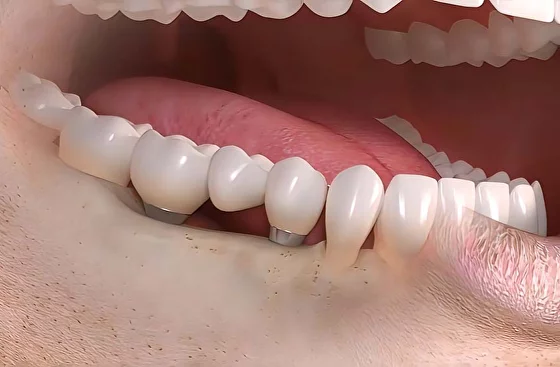
E-max ceramic bridges are placed in the anterior area. The material has impeccable aesthetics; it imitates the translucency of tooth enamel (indistinguishable from the dentition).
Zirconia bridges are manufactured using PIC technology from zirconium dioxide for a precise fit. Zirconia bridges are placed on molars or premolars because this material withstands high chewing loads.
Diagnosis
Stages of a smile makeover with a dental bridge
After diagnosing and studying your medical history, the doctor makes a treatment plan and chooses the material and placement method for the bridge.
We perform comprehensive oral hygienic procedures, treat caries (if necessary), and stop gum inflammation.
- We prepare the supporting units: preparing dentin, filling root canals, taking impressions.
- We place implants in the jaw. We prepare a temporary denture on the abutments using impressions.
A permanent denture will be ready and will be installed instead of an adaptation denture 4 days after taking the impressions. The doctor checks the position in the mouth, the intermaxillary contact, and the gingival contour; and eliminates any discomfort from biting.
We plan a preventive checkup every 2 weeks after the fixed denture is placed. This is a mandatory stage of treatment; it is needed to stabilize the orthopedic structure in the bite.
Preventive care
FAQ
Implant prosthetics can stop atrophy and preserve the integrity of the dentin and pulp of healthy units. A bridge on your natural teeth is recommended when the units are already damaged or need to be strengthened.
How long a dental bridge will last depends on following the doctor’s recommendations and attending professional checkups. The service life of the denture material is up (but not limited) to 10 years.
The adjacent units may shift toward the interdental space, and bone atrophy may develop. If you delay prosthetics, there is a high risk of losing healthy units.

